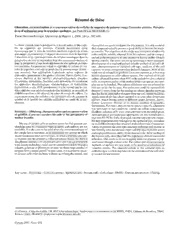
Obtention, caractérisation et cryoconservation de cellules de nageoire de poisson rouge Carassius auratus. Perspectives d’utilisation pour le transfert nucléaire PDF
Preview Obtention, caractérisation et cryoconservation de cellules de nageoire de poisson rouge Carassius auratus. Perspectives d’utilisation pour le transfert nucléaire
Résumé de thèse Obtention, caractérisation et cryoconservation de cellules de nageoire de poisson rouge Carassius auratus. Perspec- tives d’utilisation pourle transfert nucléaire, par Paul-Erwan MAUGER (1) Thèse Mention Biologie, Université de Rennes 1, 2006, 243 p., 382 réfs. La thèse s’inscrit dans la perspective, à moyen terme, d’être capa- fin explants are good candidates for this purpose. It is also essential ble de régénérer des poissons d’intérêt patrimonial et/ou that cryopreserved cells possess a good ability to be used for nucle- économique par la voie du transfert nucléaire à partir de tissus ar transfer. The objective of the study was to explore whether fin somatiques cryoconservés. L’objectif des travaux était de fiabiliser cells could be reliably obtained from fin explants, and be cryopre- l’obtention et la cryoconservation de cellules somatiques dans la served in the perspective of later studies on fin cell ability towards perspective de leur incorporation dans des cryoconservatoires, et nuclear transfer. The study was set up according to three strategies: dans la perspective d’une étude ultérieure de leur aptitude au trans- development of a standardized and reliable method of fin cell cul- fert nucléaire. Un protocole validé et répétable de culture de cel- ture, characterization of cultured cell type, analysis of fin cell lules de nageoires a été mis au point chez le poisson rouge (C a r a s - capacity to resist cryopreservation-induced damages. Most of the sius auratus). Son application à plusieurs autres espèces de work was developed on goldfish Carassius auratusas a first step téléostéens appartenant à des genres (Abramis, Danio, Gobio, Leu - before adaptation to other teleost species. Our method of fin cell ciscus, Rutilus) et des familles phylogénétiquement distantes culture allowed that more than 90% of the tested fins give cultured (Cyprinidae, Salmonidae, Percidae) a été démontrée. En combinant cells, an essential quality of the method when rare species and sam- les approches morphologique, immunologique et moléculaire ples are to be handled. The culture efficiency was not affected by (hybridation in situ, PCR quantitative), il a été montré que les cel- fish sex or by the fin type. Fin collection could be successfully lules cultivées sont exclusivement de type épithélial, et un profil de delayed (3 days) from the fin seeding in culture, thereby allowing d é d i fférenciation a été observé au cours du temps de culture. La that the fin be collected at distance from the cell culture facilities. cryoconservation des cellules a été optimisée afin de garantir le Application of the fin culture method to several other freshwater nombre et la qualité des cellules utilisables au sortir de la cry- species, which belong either to different genus Abramis, Danio, obanque. Gobio, Leuciscus, Rutilus or to distant families (Cyprinidae, Salmonidae, Percidae), proved that no species-specific adaptation was necessary in our conditions, except for culture temperature. S u m m a ry. - Obtaining, characterization and cry o p re s e r v a t i o n Goldfish cultured cells were characterized with morphological, of goldfish (Carassius auratus) fin cells in the perspective of immunological and molecular approaches (in situh y b r i d i z a t i o n , nucleartransfer. real time RT-PCR). Cells displayed variable and transient shapes, but they homogeneously belonged to the epithelial type. At e n d e n- The use of somatic cells as nucleus carrier for fish genome cry- cy to dedifferentiation was observed with culture time. Cryopreser- obanking must be considered when gametes and embryos are not vation of goldfish fin cells with dimethyl sulfoxide and sucrose at available. It is the case in the wild when the maturational state of low freezing rates maintained a high viability (dye exclusion assay) the caught fish is uncertain, or in aquaculture for species in which and high proliferation ability of the thawed cells. After seeding of sexual maturation takes several years, or when a dramatic epizooti- the thawed cells, more than half the population showed successful cy requires that the genome is collected quickly before the stock is adhesion. This study is an encouraging basis for genome cryop- slaughtered. Somatic cell cryopreservation and fish reconstruction reservation through somatic cells. The culture and cryopreservation with cloning technology could also be considered for fish bearing a methods set up here are now ready to be used for cryobanking of valuable genotype or phenotype, in order to obtain large number of valuable strains. The characterization of the cultured cells as progeny from a single animal. In most cases, it is essential to recov- epithelial type is a first step towards the estimation of the cell abili- er somatic cells from the body without sacrificing the animal, and ty toward nuclear transfer. Key words. - Cyprinidae - Carassius auratus- Epithelial cells - Somatic cells - Cell culture - DMSO - Genome preservation - Cloning. (1) Contact : Catherine Labbé, UR 1037 Ichtyophysiologie, biodiversité et environnement (SCRIBE), INRA, Campus de Beaulieu, 35042 Rennes CEDEX,FRANCE. [[email protected]] Cybium 2007, 31(4): 426.
